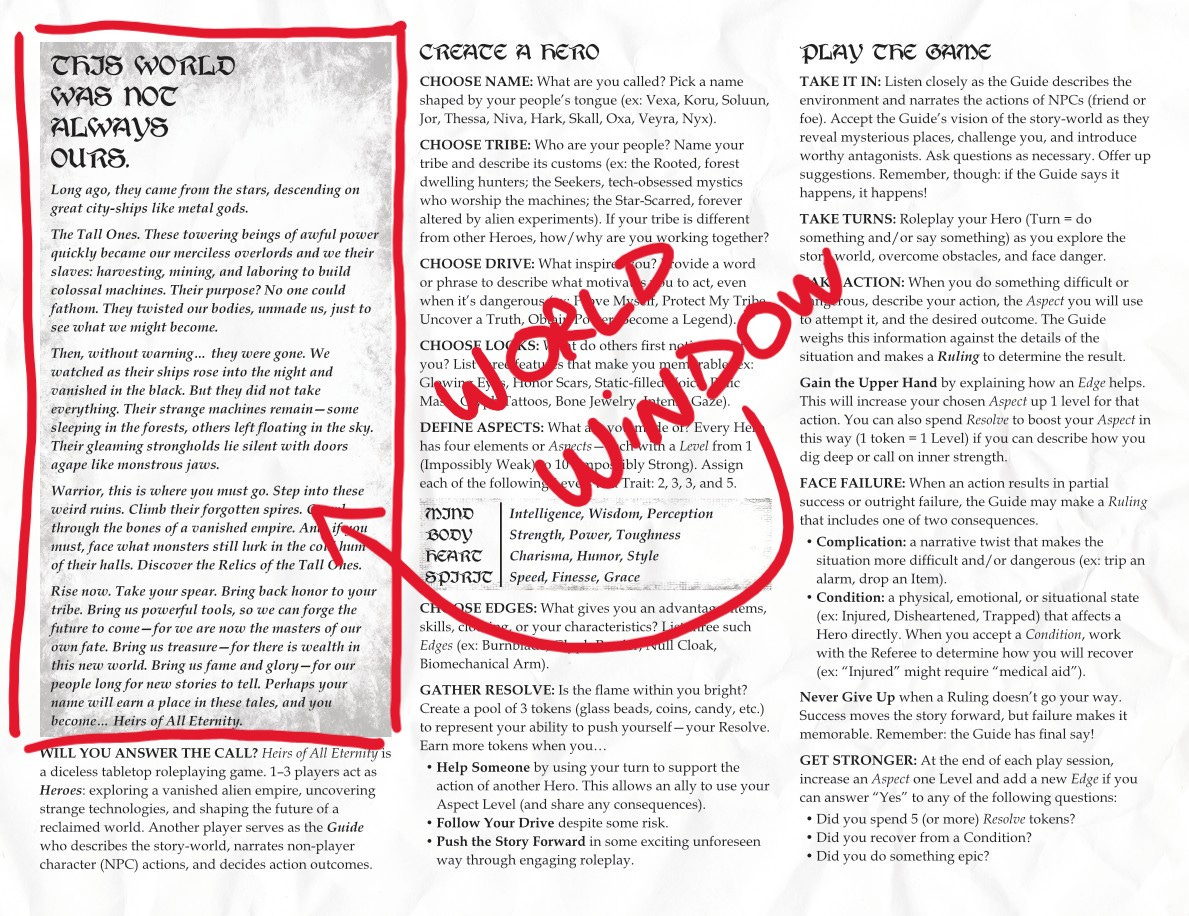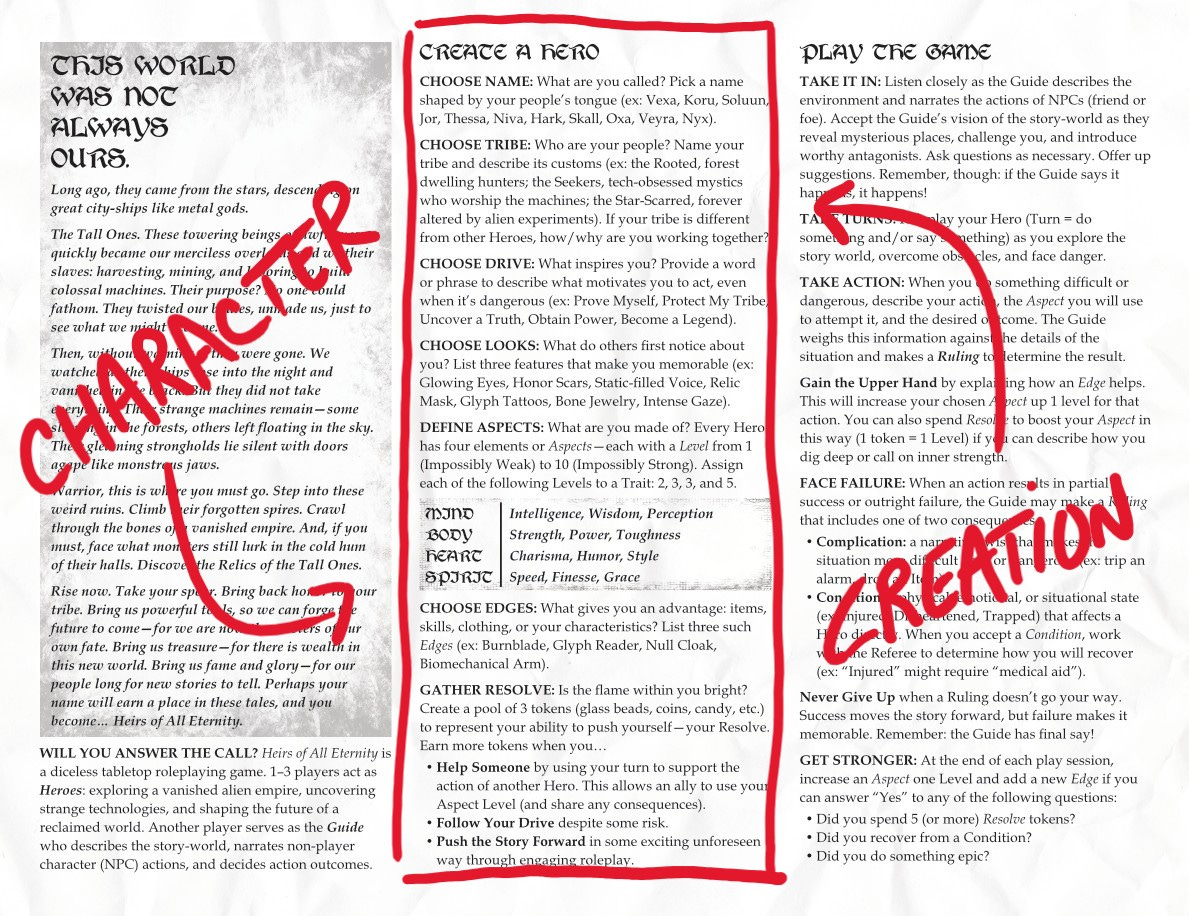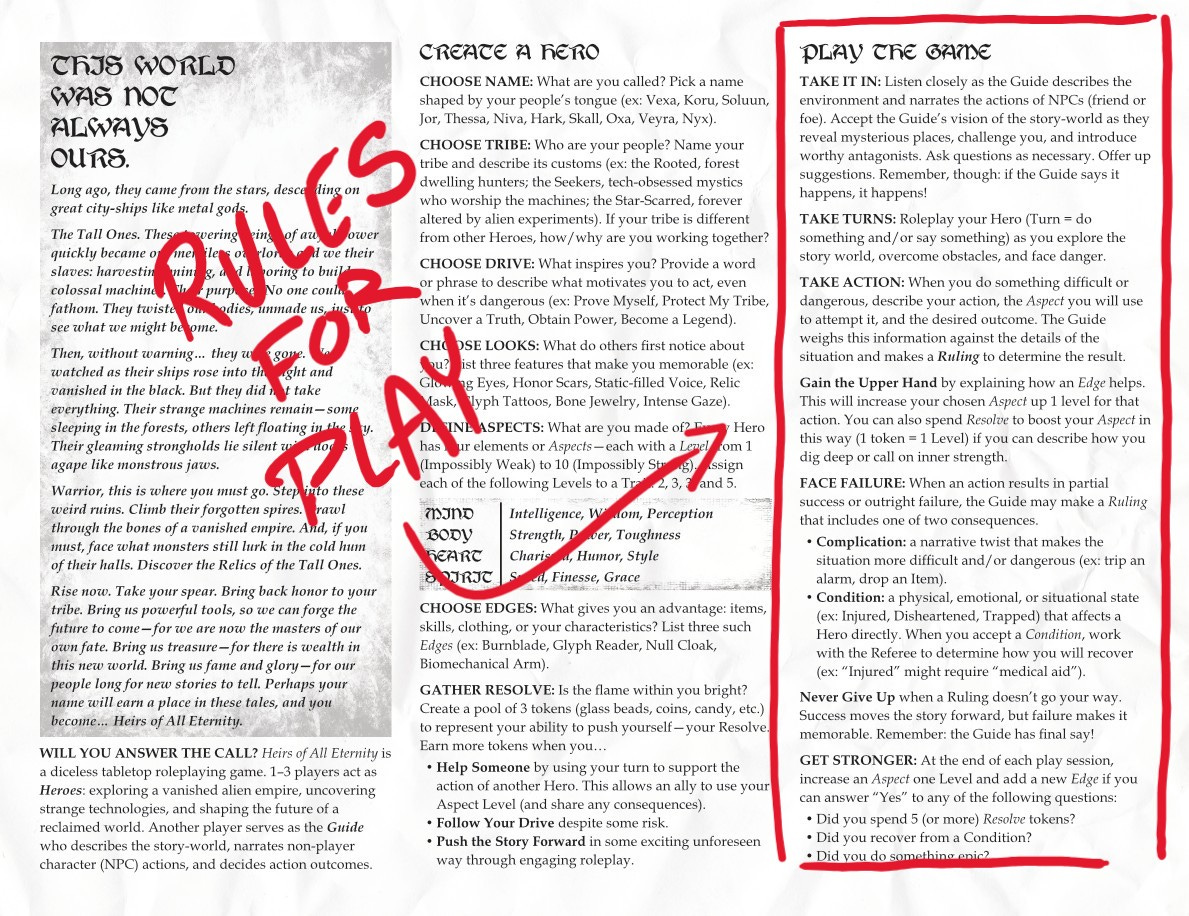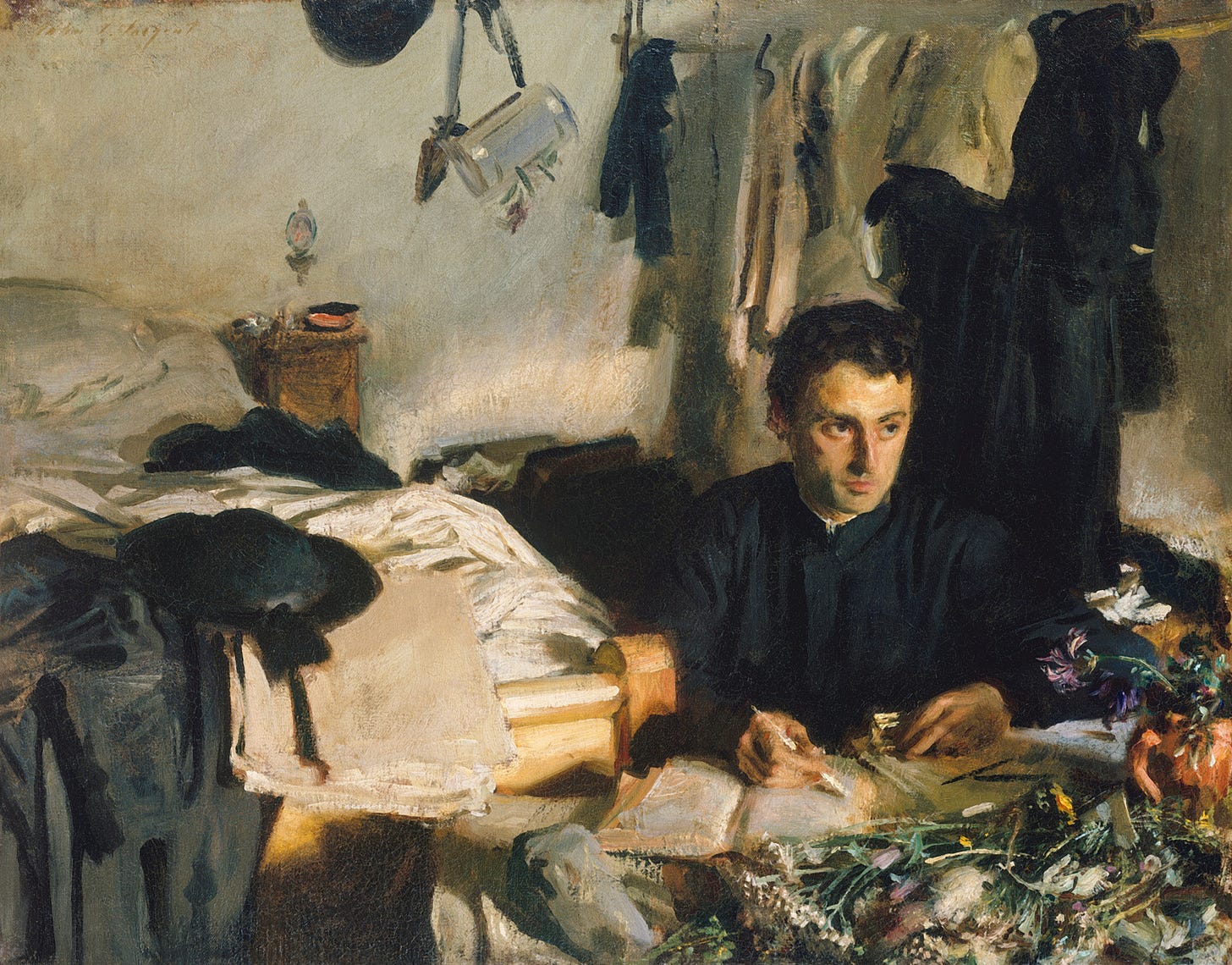Let’s Explore, Create, and Grow Together!
Embark on The (Side) Quest: A journey into tabletop roleplaying games, storytelling, and beyond.
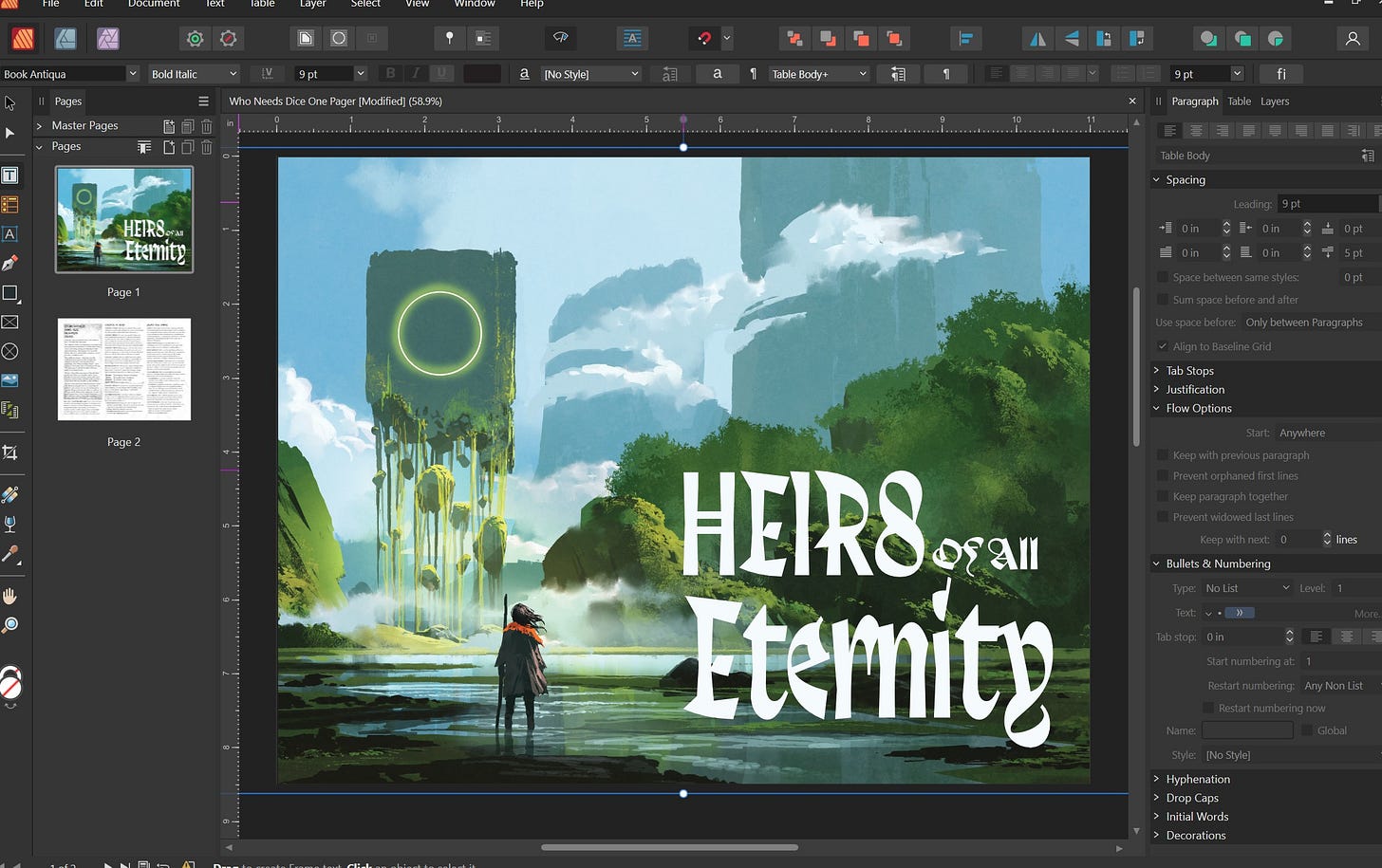
WAIT… ONLY ONE PAGE?
When I think of a “fully playable” tabletop roleplaying system, Dungeons and Dragons is what first comes to mind—with its 200+ page Players Handbook filled with lore, mechanics, race and class traits, spells, weapons/armor lists, and more. Then, of course, there’s more information in the Dungeon Master’s Guide. Oh. And there’s the Monster Manual, too. Don’t forget that…
Can all of this stuff be squeezed into one page of text?
That’s the challenge of the One-Page RPG Jam where “submissions must be a fully playable RPG system on a single sheet of paper.”
I aim to submit an entry.
Last year I designed Burden n’ Blade, my first (for-real) published game. I wrote a blog post not too long ago reflecting on the results (“The One-Page Journey”), and I theorized that a one-pager really only needs five things:
World Window
Character Creation
Rules/Guidelines for Play
Resolution Mechanic
Advancement
So, for this year’s One-Page RPG Jam, I’m applying this approach to a new game. I call it Heirs of All Eternity. It’s a diceless, post-alien-apocalypse RPG about scavenging strange relics from forgotten ruins.
Yeah. When I just read that out loud, I can hear the weirdness… But it’s an idea that’s been rattling around in my brain for several months now.
Anyway, I've decided to share the process of designing this game. So, if you’ve ever wanted to make your own one-page RPG (and I recommend it) maybe this walkthrough will help?
Come along on my one-page journey!
THE WORLD WINDOW
Imagine a retail storefront, filled with stylishly dressed body forms or plastered with “SALE” signs. This space answers two questions for the customers walking past. What products can I buy in that store? Why should I buy those products from that store?
The first column of a one-pager is basically the same thing.
That’s why I wanted to start my game with a “World Window.” It’s a short bit of prose that presents the players with a peek into the game world, and hopefully moves them to keep on reading.
For Heirs of All Eternity I imagined this epic fantasy landscape dotted with strange, alien ruins—each one filled with crazy alien tech—ready for exploration. The old-school Saturday morning cartoon Thundarr The Barbarian wasn’t far from mind.
It’s a place I’d like to explore as a player, and I tried to capture that with my World Window.
THIS WORLD WAS NOT ALWAYS OUR OWN…
Long ago, they came from the stars, descending on great city-ships like metal gods.
The Tall Ones. These towering beings of awful power quickly became our merciless overlords and we their slaves: harvesting, mining, and laboring to build colossal machines. Their purpose? No one could fathom. They twisted our bodies, unmade us, just to see what we might become.
Then, without warning… they were gone. We watched as their ships rose into the night and vanished in the black. But they did not take everything. Their strange machines remain—some sleeping in the forests, others left floating in the sky. Their gleaming strongholds lie silent with doors agape like monstrous jaws.
Warrior, this is where you must go. Step into these weird ruins. Climb their forgotten spires. Crawl through the bones of a vanished empire. And, if you must, face what monsters still lurk in the cold hum of their halls. Discover the Relics of the Tall Ones.
Rise now. Take your spear. Bring back honor to your tribe. Bring us powerful tools, so we can forge the future to come—for we are now the masters of our own fate. Bring us treasure—for there is wealth in this new world. Bring us fame and glory—for our people long for new stories to tell. Perhaps your name will earn a place in these tales, and you become… Heirs of All Eternity.
I mean, if our game is to be a “fully playable RPG system on a single sheet of paper, it should provide a setting for players to explore, right? But with only one page, we need to keep the word count super low. I ended up getting it down to about 230 words… after tons of revising and cutting (turns out this part of one-pager design is the most difficult for me, by far)!
If you're stuck on your World Window, it helped me to organize the section chronologically:
Past: What was life like? Why/how was it difficult or dangerous? Or what was it like in the good ol’ days?
Present: What’s the current situation? How have things changed or perhaps escalated?
Future: What happens now? Give the players a Call To Adventure: “Rise now. Take your spear… Bring us powerful tools… Bring us glory.”
If you want to read more about World Windows (with some popular mentor examples) check out my previous post on “The One Page Journey.”
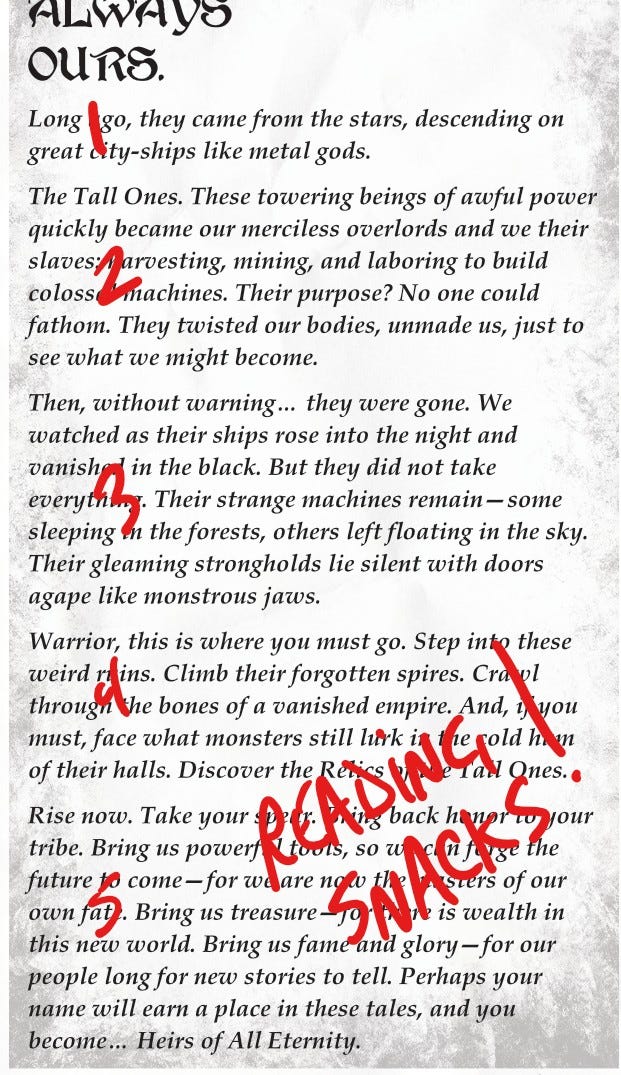
CHARACTER CREATION
To be a complete RPG system, a one-pager must also lead players through creating a unique hero.
And… Now that the World Window has set up the game’s setting, conflicts, and tone (and the player has decided to answer that Call to Adventure), it makes sense for Character Creation to come next. After all, the Rules for Play, Mechanics, and Advancement sections will make way more sense with stats and whatnot already explained.
Here’s what I ended up with.
CREATE A HERO
CHOOSE NAME: What are you called? Pick a name shaped by your people’s tongue (ex: Vexa, Koru, Soluun, Jor, Thessa, Niva, Hark, Skall, Oxa, Veyra, Nyx).
CHOOSE TRIBE: Who are your people? Name your tribe and describe its customs (ex: The Rooted, forest dwelling hunters; The Seekers, tech-obsessed mystics who worship the machines; The Star-Scarred, forever altered by alien experiments). If your tribe is different from other Heroes, how/why are you working together?
CHOOSE DRIVE: What inspires you? Provide a word or phrase to describe what motivates you to act, even when it’s dangerous (ex: Prove Myself, Protect My Tribe, Uncover a Truth, Obtain Power, Become a Legend).
CHOOSE LOOKS: What do others first notice about you? List three features that make you memorable (ex: Glowing Eyes, Honor Scars, Static-filled Voice, Relic Mask, Glyph Tattoos, Bone Jewelry, Intense Gaze).
DEFINE ASPECTS: What are you made of? Every Hero has four elements or Aspects—each with a Level from 1 (Impossibly Weak) to 10 (Impossibly Strong). Assign each of the following Levels to an Aspect: 2, 3, 3, and 5.
MIND (Intelligence, Wisdom, Perception)
BODY (Strength, Power, Toughness)
HEART (Charisma, Humor, Style)
SPIRIT (Speed, Finesse, Grace)
CHOOSE EDGES: What gives you an advantage: items, skills, clothing, or some characteristic? List three such Edges (ex: Burnblade, Glyph Reader, Null Cloak, Biomechanical Arm).
GATHER RESOLVE: Does the flame within you burn bright? Create a pool of 3 tokens (glass beads, coins, candy, etc.) to represent your ability to push yourself—your Resolve. Earn more tokens when you…
Help Someone by using your turn to support the action of another Hero. This allows an ally to use your Aspect Level (and share any consequences).
Follow Your Drive despite some risk.
Push the Story Forward in some exciting unforeseen way through engaging roleplay.
At the most basic level, character creation really only needs to answer one question: “What is my character good at?”
But… man! There is just too much stuff I want to include—all these bits and pieces inspired from other games. So, For Heirs of All Eternity I ended up using all of column two.
Still, there’s just not enough room on one third of one 8.5 x 11 sheet to include all the character creation goodness I want! I mean, I was hoping to give all kinds of choices (It would be cool if the rules doubled as a character sheet!), but I have to settle for providing a couple of suggestions in this format; (ex: something, something, and so on).
The good news? With the way it’s written now, I have “everything necessary to play the game” on the front side of my One-Page RPG. However, according to the jam submission guidelines, you can use the other side of the page for rollable tables, character sheets, “Running the Game” advice, or other extras.
So… I’ll leave my little suggestions here and save room for full-out lists and/or rollable tables of names, drives, edges, etc. on the other side.
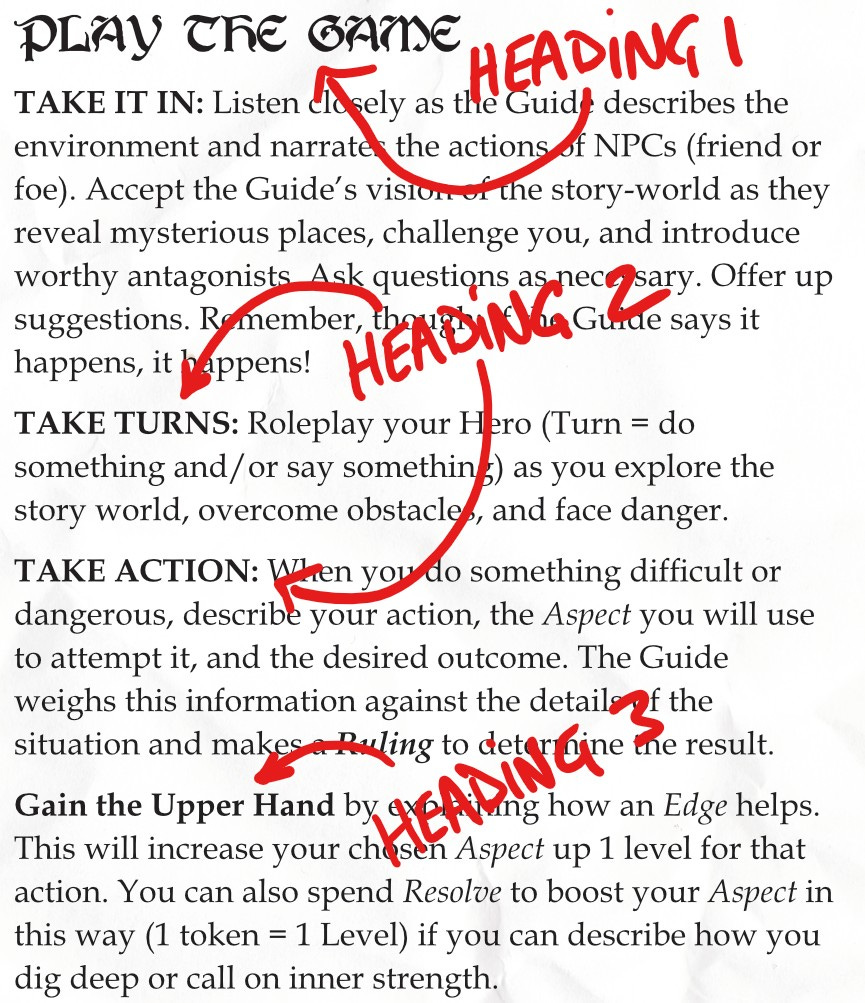
PLAYING THE GAME
Well… the good news: I’ve got one column of page space left. The bad news: I still need to explain how you actually play the dang game!
It helped me to break this section into three main parts.
Rules For Play
How do you shove “This is How You Play a Tabletop Roleplaying Game” into 100-200 words? I figure there are (at least) three ideas you need to explain.
What do the Players do? Players take turns doing and saying things as their character. They often rely on attributes or stats (and other character info) to determine what happens.
What does the Game Master (or Guide) do? The Guide describes the world and everything that occurs within it. They rely on narrative skills and imagination to determine what happens.
What’s the relationship between the Guide and Player? The Guide has final say, sure, but both sides participate in a collaborative (not competitive) effort to tell a cool story. Everyone listens, reacts, and builds this story together.
Here’s the fast-n-loose summary I ended up with:
TAKE IT IN: Listen closely as the Guide describes the environment and narrates the actions of NPCs (friend or foe). Accept the Guide’s vision of the story-world as they reveal mysterious places, challenge you, and introduce worthy antagonists. Ask questions as necessary. Offer up suggestions. Remember, though: if the Guide says it happens, it happens!
TAKE TURNS: Roleplay your Hero (Turn = do something and/or say something) as you explore the story world, overcome obstacles, and face danger.
It’s probably safe to assume most one-page RPG players have some kind of roleplaying experience, and I wanted Heirs of All Eternity to follow a pretty traditional formula. Meh… I think that’s enough.
Resolution Mechanic
I’ve been interested in diceless TTRPG systems for some time.
Think about it. If you “win” a table-top RPG like Dungeons & Dragons by telling a "collaborative story” and… we humans have been telling stories since way, way, way, back-in-the-day, it seems a system based 100% on player choice could be an intuitive/natural way to capture this experience (I wrote more about this in one of my first Substack posts, “The Challenge”).
Anyway, I found this Diceless Universal rules doc on Itch, and I thought it was a really clever concept. So, I adapted (aka “hacked”) its resolution mechanic, for Heirs of All Eternity… adding some Landshut-Free-Kriegsspiele-inspired aspects and mixing in a narrative approach to dealing with “failure.”
This is what I ended up with:
TAKE ACTION: When you do something difficult or dangerous, describe your action, the Aspect you will use to attempt it, and the desired outcome. The Guide weighs this information against the details of the situation and makes a Ruling to determine the result.
Gain the Upper Hand by explaining how an Edge helps in a situation. This will increase your chosen Aspect up 1 level for that action. You can also spend Resolve to boost your Aspect in this way (1 token = 1 Level) if you can describe how you dig deep or call on inner strength.
FACE FAILURE: When an action results in partial success or outright failure, the Guide may make a Ruling that includes one of two consequences.
Complication: a narrative twist that makes the situation more difficult and/or dangerous (ex: trip an alarm, drop an Item).
Condition: a physical, emotional, or situational state (ex: Injured, Disheartened, Trapped) that affects a Hero directly. When you accept a Condition, work with the Guide to determine how you will recover (ex: “Injured” might require “medical aid”).
Never Give Up when a Ruling doesn’t go your way. Success moves the story forward, but failure makes it memorable. Remember: the Guide has final say!
Full disclosure: I haven’t play-tested this at all. Not one bit.
But… (in theory) it seems like it would work well.
It’s fast. No hunting for dice or calculating modifiers (ugh… math). Just describe your action, get the Ruling, and go. Right? I really like the emphasis on choice here, too. The story is shaped by the interaction between player and Guide (with perhaps some deliberation)—not the dice. And I like these consequences. Complications and Conditions add tension but diminish Player vs. Guide animosity (nobody is losing hit points and making “death saves”).
It’s a simple mechanic, but it invites discussion (dare I say camaraderie?) and pushes the story forward—success or failure. I dig it.
Advancement
My first one-pager, Burden N’ Blade didn’t have a way for players to advance, so I really wanted to make that a part of Heirs of All Eternity.
GET STRONGER: At the end of each play session, increase an Aspect one Level and add a new Edge if you can answer “Yes” to any of the following questions:
Did you spend 5 (or more) Resolve tokens?
Did you recover from a Condition?
Did you do something epic?
I like how these incentivizes players to follow their Drive (so they can get tokens to spend) and face big challenges (spend tokens to succeed/accept a Condition with failure). It’s not a robust leveling system by any means, but I think it could support long-term play (at least longer than one session).
That’s important to me. I’m hoping players will come back for more.
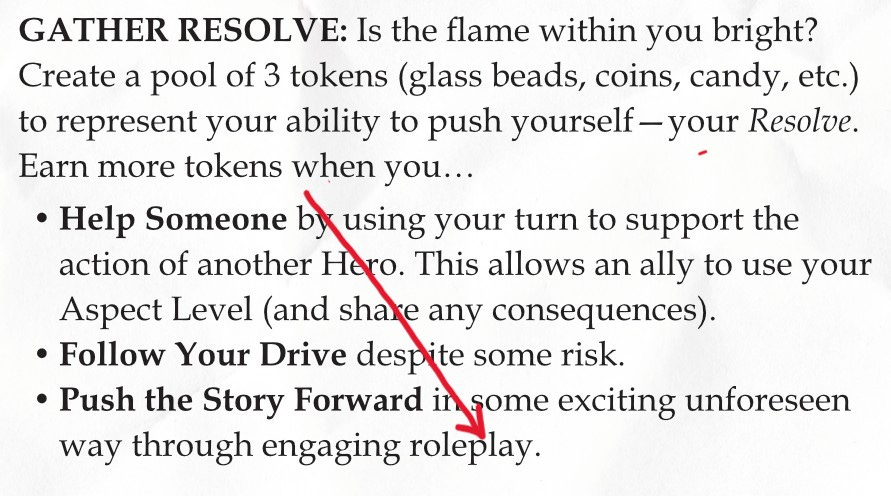
ONE PAGE IS ALL YOU NEED
This is from the One-Page RPG Jam homepage:
“Entire rules-lite roleplaying systems on single sheets of paper. One-page RPGs are often easy to pick up and learn, allowing you to spend more time playing and less time reading.”
And… It’s crazy how a single sheet of text can spark an entire fantasy (or sci-fi) world.
This is why I love one-pagers!
Designing Heirs of All Eternity has already taught me so much (and I’m not even done). It’s forced me to rethink rules and mechanics. It’s pushed me to focus on clarity and tone. And it’s helped me realize that good writing/formatting/layout equals good game design.
So… what about you?
Are you ready to join the One-Page RPG Jam?
It’s a great opportunity to try your hand at game design or step back/shift from that huge project you’ve been working on for the last year… all without a huge commitment. For me, writing a one-pager is how I dust off some old ideas and bring them to life (in just a week or two of work, too)! If it’s really good… well, I can expand it later, right?
You might discover that one page is all you need.


